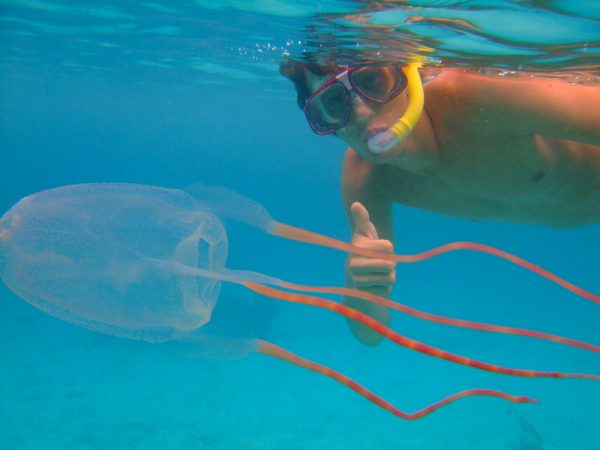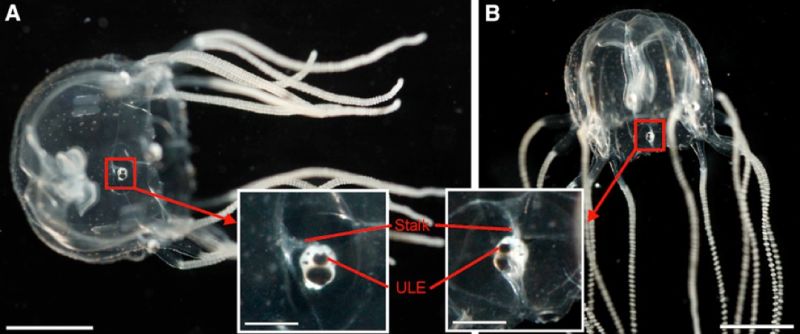Jellyfish are blobs lazily floating in the oceans. They move calmly and gracefully. They are harmless but Box Jellyfish are nothing like that. They are very dangerous and can be fatal to humans. They have evolved over 700 million years ago. So if you are interested in learning more or if you are a marine biologist who`s wondering “What info can help me to do my coursework” . We have gathered some really interesting and informative Box Jellyfish Facts for Kids that will help you in learning all about the Box Jellyfish. So continue reading and do let us know in the comments what do you think about this deadly jellyfish.
Box Jellyfish Facts for Kids
What is a Box Jellyfish?
Box Jellyfish are the most dangerous jellyfish in the world. They are also called sea wasps and marine stingers. They are called ‘Box’ because of the cube-like shape of their bell. Their average life span is less than a year. According to studies, they swim faster than Olympic swimmers.

Box Jellyfish Classification
| Kingdom: | Animalia |
| Phylum: | Cnidarian |
| Class: | Cubozoa |
| Scientific Name: | Cubozoa |
Box Jellyfish Description
- All jellyfish are invertebrate animals. They do not have a backbone in their bodies.
- Box Jellyfish are light blue.
- About a dozen tentacles grow from each corner of the bell.
- The tentacles grow up to 10 feet (3 meters) in length and have about 5,000 stinging cells.
Box Jellyfish Size
- They weigh up to 4.5 lbs. (2 kg).
- An adult Box Jellyfish can measure up to 20 cm along each box side.
- The tentacles grow up to 3 meters in length.
Read more: How big do box jellyfish get?

Box Jellyfish Eyes
- Box Jellyfish has a complex visual system.
- They have 24 eyes. The eyes are categorized into four different kinds.
- They are located on a circular structure in the middle of the jellyfish’s bell.
- The upper and lower set of eyes can form images. They help jellyfish see, navigate and avoid obstacles. They also respond to light.
- The other two sets of eyes are primitive.
- Researchers have shown that the Box Jellyfish can detect food 10 meters away.
- Their eyes have a visual field of 90 to 100 degrees.
Do you want to know more about Box Jellyfish Eyes? Read this:

How does the Box Jellyfish move?
- Most jellyfish cannot control their movement and move by drifting in the water currents.
- Box jellyfish controls their movement. They can maneuver their motion.
- The main body of a jellyfish is called medusa. Box Jellyfish have long and narrow medusa, which helps in guiding their body through the water.
- Their ability to maneuver in the water helps them follow and catch prey, instead of hoping that food will float past through.
- Their self-control movement also helps them to get away from predators.
- They can swim at a speed of 1.5 to 2 meters per second.
How does Box Jellyfish sleep?
All jellyfish sleep at night and hunt during the day. They sleep at the bottom of the ocean floor.
Box Jellyfish Diet – What do Box Jellyfish Eat
- Box Jellyfish are carnivores i.e. they eat other living things.
- Their favorite food includes:
- Arrow worms
- Annelid worms
- Shrimps
- Prawns
- Small fishes
- Crayfish
- Krill
Learn more about: What Do Box Jellyfish Eat
How does the box Jellyfish get their food?
- First, they paralyze their prey with their toxic sting.
- After the prey is immobilized, they pull their prey into the mouth and engulf it as a whole. A Jellyfish’s mouth is a hole in its body. When it digests its food, the waste is released through the same hole.
- It eats its prey in less than one minute.
How does Box Jellyfish Reproduce?
- They produce both, sexually and asexually.
- Irrespective of a Box Jellyfish gender, it can offer both sperm and eggs independently.
- Sexual reproduction happens in the adult stages. Adult Box Jellyfish releases sperm and eggs in the water. When sperm mix with eggs, it creates larvae. The larvae are called Planula.
- Planula reproduces asexually. They produce clones of themselves. These clones are attached to the planula until they become adults. When the clones develop mouth, eyes, and tentacles, they detach from the original planula and grow into adults Box Jellyfish.
Read more: How Box Jellyfish Reproduce?
Box Jellyfish Habitat – Where does Box Jellyfish live
- They live in mangrove swamps. Mangroves are small trees that grow in coastal salty water.
Read more: Box Jellyfish Habitat
Box Jellyfish Distribution
- They are found near the shores of the Northern Australian oceans. However, their main habitat is the waters where the Indian Ocean and the Pacific Ocean meet together.
- Researchers have also seen them near Japan and California Coast.
- They also live off the coasts of Vietnam, Hawaii, and the Philippines.
Read more: Box Jellyfish Season Australia
Box Jellyfish Predators
- Sea turtles and some large fish feed upon Box Jellyfish.
- The shell of turtles protects Box Jellyfish sting.
Read more: What Eats Box Jellyfish?
Box Jellyfish Sting
- Box Jellyfish sting is fatal.
- It can lead to death or permanent tissue damage.
- The venom paralyzes its prey by attacking the nervous system, heart, and skin cells.
Read more:
Why is Box Jellyfish Harmful?
- Like all jellyfish, it can sting you. The venom in its sting is so toxic that it can kill you. The venom will slow down your heartbeat and shut down your nervous system.
- The sting of Box Jellyfish is so harmful that even if you survive it, you probably will have permanent damage to your body.
Box Jellyfish sting victim
The victim of Box Jellyfish suffers from the following effects
- Abnormal heartbeat
- Very high blood pressure
- Nervous system breakdown
- Vomiting
- Headaches
- Agitation
- Profuse sweating

Box Jellyfish sting treatment
- First, get the person out of the water. Then, immediately check his blood circulation and breathing. Keep him in an open, airy space.
- Australian Resuscitation Council recommends applying vinegar to the area where you get stung.
- Vinegar deactivates stinging organelles that have not yet fired off the venom. However, if the organelle has already fired off, then do not use vinegar.
- Remove the tentacles by scraping them with a plastic object.
- After removing the tentacles, place the affected arm or leg in hot water at 40 to 45O C for 30 minutes.
- For itching and swelling, use an oral antihistamine.
- In the worst-case scenario, the person may be hospitalized.
Box Jellyfish interesting facts
- A group of Box Jellyfish is called smack or fluther.
- Sea turtles feed upon Box Jellyfish because they are immune to the sting of Box Jellyfish.
- Scientists know more than 50 species of Box Jellyfish.
- Its nervous system is more developed than other jellyfish.
- Its nickname is ‘sucker punch jellyfish’.
- Box Jellyfish have 24 eyes.
Read more: Do box jellyfish have brains?






how much did the larva weigh and how big were they
I know right!!!!!!!!!!
i dont get this
burh thats whild
how much and how often does it eat?
Im never going in the ocean again
Yee Yee Wichh une goot stoong
WHETHER ITS YOUNG ARE BORN OR HATCH FROM EGGS?
You can read about this at: How Do Box Jellyfish Reproduce
do jellyfish have buts
At what age do BoxJellyfish become adults
i’m interested in box jellyfish